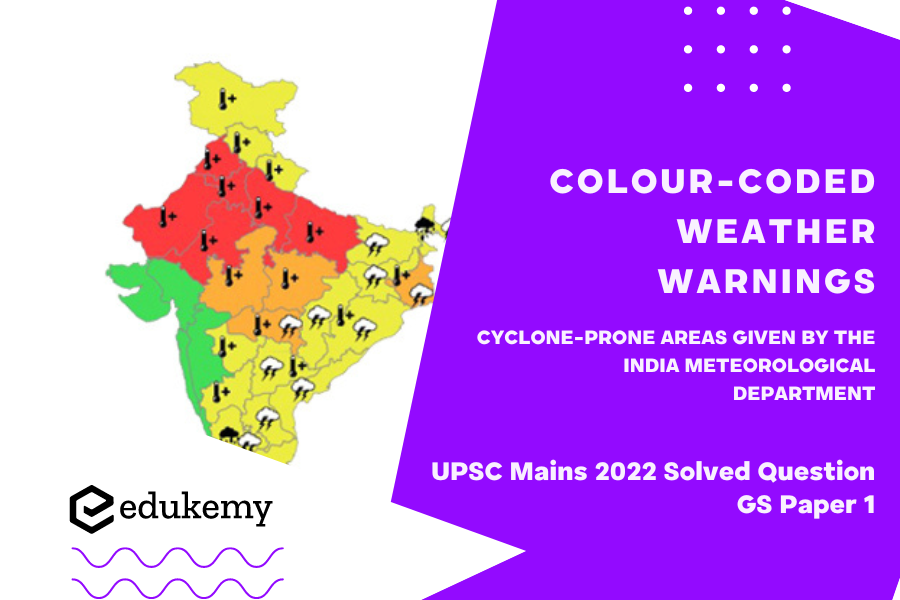In cyclone-prone areas, the India Meteorological Department (IMD) plays a crucial role in safeguarding communities by issuing color-coded weather warnings. These warnings serve as a visual language, conveying the severity of impending cyclones and guiding residents, emergency responders, and authorities in making informed decisions. The color-coded system is designed to communicate the potential impact and urgency of the approaching cyclone, offering a concise and universally understood means of relaying vital information. Understanding the meaning behind these color codes is essential for residents to prepare adequately and respond effectively to the dynamic and often hazardous weather conditions that cyclones bring. In this context, the color-coded warnings become a lifeline, empowering individuals and communities to navigate the challenges posed by cyclones with a heightened sense of awareness and readiness.
UPSC Mains General Studies Paper – 1 Mains 2022
Important Geophysical phenomena
UPSC Mains Civil Services IAS Exam Question Paper – 2022
Approach
- Introducing with emphasis insight with keywords of the severity of color-coded weather warnings for cyclone-prone areas.
- Elaborately deals with mitigation on risk assessment and Vulnerability Mapping with the Environmentally Sustainable Development and climate Change Adaptation to combat health hazards and socio-economic damages.
Introduction
The India Meteorological Department (IMD) issues color-coded weather warnings to inform the public about the severity of an impending cyclone in cyclone-prone areas. The warnings are issued based on the expected wind speed and the potential impact on the region.
Body
These alerts are also issued during thunderstorms/squalls, heat waves, dust storms, heavy snowfall, and floods depending on the amount of water rising above land /in a river as a result of torrential rainfall to provide inputs to disaster management authorities for the management of severe weather events. These color-coded warnings are universal and can be used for a wide range of natural calamities, and other dangerous weather events. Warnings are updated daily.
The IMD uses 4 colour codes:
- Green (All is well): No advisory is issued.
- Yellow (Be Aware): Yellow indicates severely bad weather spanning several days. It also suggests that the weather could change for the worse, disrupting day-to-day activities.
- Orange/Amber (Be prepared): The orange alert is issued as a warning of extremely bad weather with the potential of disruption in commute with road and rail closures, and interruption of power supply.
- Red (Take Action): When extremely bad weather conditions are certainly going to disrupt travel and power and have significant risks to life, the red alert is issued.
The color codes are based on the probability of occurrence of the event as well as its impact assessment with wind speed concerning intensity in cyclone-prone areas. They are decided on various factors such as meteorological factors, hydrological factors, and geophysical factors, indicating the risk.
Conclusion
The color-coded weather warnings issued by the IMD are designed to inform the public about the severity of an impending cyclone and provide guidance on how to protect themselves and their property.
Frequently Asked Questions (FAQs)
1. What are the different color-coded warnings for cyclones issued by the India Meteorological Department?
A: The India Meteorological Department issues color-coded warnings to communicate the severity of an approaching cyclone. The color-coded system typically consists of three levels:
- Green: This indicates that there is no immediate danger, and the weather conditions are normal. People in the affected areas are advised to stay updated with the latest weather information but can continue with their regular activities.
- Yellow: This signifies that the cyclone is approaching and may cause adverse weather conditions. People in the affected areas are advised to be cautious, stay informed about weather updates, and take necessary precautions.
- Red: A red warning is issued when a cyclone is imminent, and there is a high likelihood of severe weather conditions. People in the affected areas are urged to take immediate and necessary actions to ensure their safety, which may include evacuation to designated shelters.
2. What actions are recommended for the public when each color-coded warning is issued?
- Green Warning: During a green warning, the public is generally advised to stay informed and keep an eye on the weather updates. There might not be an immediate threat, but it’s crucial to stay prepared and follow any instructions from local authorities.
- Yellow Warning: When a yellow warning is issued, people are recommended to start taking precautionary measures. This may include securing homes, stocking up on essential supplies, and having an evacuation plan in place. It’s a signal to be prepared for worsening weather conditions.
- Red Warning: A red warning indicates a high level of danger. People are strongly advised to follow evacuation orders promptly, move to safe shelters, and take all necessary precautions to protect life and property. Ignoring a red warning can be extremely risky.
3. How does the IMD determine when to issue each color-coded warning for cyclones?
A: The IMD determines the color-coded warnings based on the analysis of various meteorological factors. These factors may include the cyclone’s intensity, its projected path, wind speeds, and other relevant data. The IMD utilizes advanced technology, satellite imagery, and weather models to make accurate predictions. The decision to issue a specific color-coded warning is made to provide timely and clear information to the public and facilitate preparedness and response actions.
It’s important for residents in cyclone-prone areas to stay connected with local authorities, follow weather updates from reliable sources, and adhere to the instructions provided during different color-coded warnings to ensure their safety during cyclonic events.
In case you still have your doubts, contact us on 9811333901.
For UPSC Prelims Resources, Click here
For Daily Updates and Study Material:
Join our Telegram Channel – Edukemy for IAS
- 1. Learn through Videos – here
- 2. Be Exam Ready by Practicing Daily MCQs – here
- 3. Daily Newsletter – Get all your Current Affairs Covered – here
- 4. Mains Answer Writing Practice – here
Visit our YouTube Channel – here



